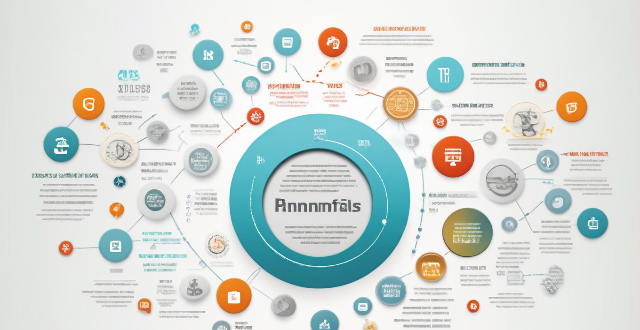Transparency Dimension

How can companies improve their ESG scores ?
Improving a company's Environmental, Social, and Governance (ESG) scores requires a comprehensive approach to business operations that emphasizes sustainability, ethical behavior, and transparency. Strategies for enhancing each aspect of the ESG framework are outlined in this guide. In the environmental dimension, companies should reduce their carbon footprint through energy efficiency, renewable energy, and green buildings; implement sustainable sourcing practices such as supply chain audits and resource stewardship; and manage waste through recycling programs and hazardous waste disposal. In the social dimension, workplace standards should be established, including fair wages, diversity and inclusion, and health and safety measures. Community engagement should also be prioritized through local investment, volunteerism, and transparency. Consumer protection is another key area, with product safety, privacy, and customer service being important considerations. In the governance dimension, board diversity and independence should be ensured through independent directors, committees, and ethical conduct policies. Transparency and accountability should also be maintained through regular ESG reporting, stakeholder engagement, and third-party audits. By focusing on these key areas, companies can improve their ESG scores and enhance their reputation, investor confidence, and long-term financial performance.

How does blockchain ensure decentralization and transparency ?
Blockchain technology ensures decentralization and transparency through a distributed ledger, consensus mechanisms like Proof of Work (PoW), Proof of Stake (PoS), and Delegated Proof of Stake (DPoS), node autonomy, immutable records via cryptographic hashing, public accessibility of the ledger, verifiable transactions using digital signatures, and smart contracts. These features create an environment resistant to manipulation and corruption, offering a paradigm shift in secure and accountable digital interactions.

How does DeFi differ from traditional finance ?
DeFi is a financial system based on blockchain technology and smart contracts, while traditional finance relies on intermediaries like banks. Key differences include centralization vs decentralization, accessibility, transparency, security, cost efficiency, and regulation. DeFi offers advantages such as wider accessibility, higher transparency, and lower fees, but also comes with risks. It's important to research and consult professionals before making financial decisions.

How do TCFD disclosures improve transparency and accountability in business practices ?
The Task Force on Climate-related Financial Disclosures (TCFD) was established by the Financial Stability Board (FSB) to develop a framework for companies to disclose information about their impact on, and from, climate-related risks. These disclosures play a crucial role in enhancing transparency and accountability in business practices. By adhering to TCFD recommendations, businesses are compelled to communicate openly about their strategies and plans related to climate change. This includes identifying and explaining the potential impact of climate change on their operations and disclosing any financial risks or opportunities that may arise due to climate change. Investors increasingly demand clarity on how companies are addressing climate change. TCFD disclosures provide this clarity, fostering trust among investors and other stakeholders. The TCFD framework sets clear benchmarks for disclosure, making it easier for stakeholders to assess a company’s performance against industry standards. This promotes comparative analysis and performance evaluation. As the TCFD gains momentum, companies are incentivized to comply not just for regulatory reasons, but also to maintain their reputation and competitive edge in the market. Knowing they must report on climate-related matters can push companies to innovate, seeking new ways to reduce environmental impacts and adapt to climate risks. With TCFD disclosures, companies are prompted to consider long-term implications of their actions, leading to more sustainable business models. The disclosures align businesses with the United Nations Sustainable Development Goals (SDGs), particularly those related to climate action and life on land. TCFD provides a global standard for reporting, ensuring that companies operating across multiple jurisdictions can be assessed consistently. Through TCFD disclosures, companies can share successful strategies and practices related to climate risk management, fostering a collaborative approach to addressing climate change. Disclosures can reveal areas where companies might need partners—whether in technology, research, or other sectors—to achieve their climate goals.

What is the difference between a regular contract and a smart contract ?
A regular contract and a smart contract differ in terms of their **nature**, **enforceability**, **cost**, **speed**, and **transparency**. Below are the key differences between these two types of contracts: ## Nature ### Regular Contract - Legal agreement between two or more parties. - Typically written in natural language (e.g., English). - Governed by local laws and regulations. ### Smart Contract - Self-executing contract with the terms directly written into code. - Deployed on a blockchain network. - Enforced by the underlying code and cryptographic protocols. ## Enforceability ### Regular Contract - Relies on legal institutions for enforcement (e.g., courts). - May involve mediation or arbitration processes. - Penalties for breach can be monetary or involve other forms of relief. ### Smart Contract - Autonomously executes when predetermined conditions are met. - Enforcement is decentralized and automated. - Penalties for breach are typically programmed into the contract logic. ## Cost ### Regular Contract - Can be costly due to legal fees, notary services, and potential litigation expenses. - Involves overhead of paper-based record keeping and manual processing. ### Smart Contract - Generally less expensive because it eliminates intermediaries. - Costs associated with blockchain transaction fees and contract deployment. ## Speed ### Regular Contract - Time-consuming process from negotiation to signing and execution. - Settlement times can vary widely depending on the complexity of the agreement. ### Smart Contract - Faster execution once the conditions are met. - Real-time settlements possible due to automation. ## Transparency ### Regular Contract - Limited transparency; only involved parties have access to the contract details. - Requires trust in the counterparty to disclose all relevant information. ### Smart Contract - High transparency; contract code and transactions are visible on the blockchain. - Trust is placed in the immutable and verifiable nature of the blockchain.

How can blockchain technology be used in voting systems to ensure transparency and fairness ?
Blockchain technology, known for its role in cryptocurrencies, can enhance voting systems by ensuring transparency, security, and fairness. It provides immutable record keeping, public verifiability, and a comprehensive audit trail. Blockchain also protects voters' identities, decentralizes the voting process, and automates vote counting. Implementing this technology requires designing the blockchain infrastructure, developing a user-friendly interface, testing, pilot programs, stakeholder education, and full implementation. However, challenges such as scalability, user adoption, legal and regulatory hurdles, and technical security must be addressed.

What is blockchain technology and how does it work ?
Blockchain technology is a decentralized, digital ledger that records transactions securely and transparently. It was originally designed for Bitcoin but has since been adapted for various applications. Key features include decentralization, transparency, immutability, and security. The technology works through transaction creation, broadcast, verification, block creation, consensus, addition to the blockchain, and perpetuation. Benefits include enhanced security, elimination of intermediaries, increased transparency, reduced costs, and improved efficiency. Blockchain technology has potential applications beyond cryptocurrency and could transform industries such as finance and supply chain management.

What ethical considerations are involved in vaccine distribution equity ?
Vaccine distribution equity is a crucial issue that requires careful consideration of ethical principles such as justice, utilitarianism, autonomy, and transparency. Justice demands that vaccines be distributed based on medical need rather than wealth or social status, while utilitarianism emphasizes maximizing overall well-being by prioritizing essential workers and those who can contribute most to society. Autonomy requires respecting individuals' choices about whether or not to receive a vaccine through informed consent and voluntary participation. Transparency is essential for building trust and promoting public confidence in vaccine distribution efforts through public communication and accountability mechanisms. Overall, ensuring equitable distribution of vaccines requires balancing these ethical considerations to promote fairness, maximize benefits, respect individual autonomy, and maintain transparency throughout the process.

How does cryptocurrency work ?
Cryptocurrency is a digital or virtual currency that uses cryptography for security, operating independently of a central bank. It allows direct transfers between individuals without intermediaries like banks. Key components include cryptography (public and private keys, encryption, decryption), blockchain technology (decentralization, transparency, immutability, consensus mechanism), mining (Proof of Work, Proof of Stake, mining rewards, network security), and smart contracts (automation, efficiency, security, transparency). These technologies work together to create a secure, decentralized, and transparent digital payment system with fast, low-cost, and borderless transactions while maintaining user privacy and security.

How can I build a strong relationship with my investors ?
The article emphasizes the importance of building a strong relationship with investors for the success of a business. It outlines several key strategies to achieve this, including communication, trustworthiness, collaboration, recognition, professionalism, and continuous improvement. The tips provided suggest that regular updates, transparency, active listening, fulfilling promises, integrity, partnership approach, joint decision making, appreciation, acknowledgement of success, punctuality, high-quality presentation materials, seeking learning opportunities, and creating a feedback loop are all crucial elements in fostering a positive relationship with investors. By following these guidelines, businesses can establish a strong foundation of trust, transparency, and collaboration that will lead to mutually beneficial relationships and ultimately contribute to the success of their ventures.

How can we address the issue of climate change denial in our communication efforts ?
Addressing climate change denial requires effective communication strategies that bridge the gap between scientific consensus and public perception. These include educating with evidence, engaging emotionally, addressing misinformation, building trust through transparency, promoting dialogue and collaboration, tailoring messaging to different audiences, empowering through action, and staying updated and flexible. By employing these strategies, we can foster a more informed and engaged public in the fight against climate change.

What policies and regulations are currently in place to encourage more sustainable supply chain practices ?
Policies and Regulations Encouraging Sustainable Supply Chain Practices discusses various government initiatives, industry standards, and international agreements that promote sustainable supply chain practices. Government policies such as green procurement, carbon pricing, and eco-labels incentivize businesses to adopt environmentally friendly operations. Industry standards like CSR and LCA help companies understand and reduce their ecological footprint. International treaties like the Paris Agreement and Basel Convention provide a global framework for sustainable practices. Together, these measures form a comprehensive system to support sustainable supply chains worldwide.

How can I enhance my facial features with makeup ?
Makeup techniques to enhance facial features include contouring, highlighting, eye makeup application, blush and bronzer use, lip enhancement, foundation and concealer application, and setting with powder and spray. These methods aim to create a balanced, polished look by defining facial areas, lifting the face, warming up the complexion, and adding dimension. Experimentation is key to finding the best techniques and products for enhancing individual facial features.

What kind of contouring and highlighting techniques do stars use ?
Contouring and highlighting techniques used by stars include using bronzer for depth, highlighter for glow, concealer for shaping, powder for setting, and brushes for application. These techniques help sculpt and define facial features, creating a more chiseled and polished look.

How can I take mouthwatering photos of desserts and pastries ?
To capture mouthwatering photos of desserts and pastries, consider the following tips: plan your composition by using the rule of thirds, negative space, and different angles; focus on lighting by utilizing natural, diffused light or shooting during golden hour; style your subject with complementary props and simple backgrounds; get close to your subject with a macro lens and shallow depth of field; play with color by considering your color palette and using contrasting colors; use post-processing software to enhance your photos; and practice regularly while experimenting with different techniques.

Are there any specific eye makeup trends followed by celebrities ?
The article discusses various eye makeup trends that are popular among celebrities. These include the classic smokey eye, cut crease technique, colorful shadows, winged eyeliner, and false lashes or lash extensions. Examples of celebrities who have embraced these trends are also provided.

How do food festivals promote cultural diversity and understanding ?
Food festivals are significant events that promote cultural diversity and understanding by offering educational opportunities, exposing attendees to new flavors, building community, impacting the economy positively, providing entertainment, enhancing social media presence and awareness, and promoting sustainability initiatives. These festivals facilitate cross-cultural dialogue, break down cultural barriers, and encourage a shared appreciation for global cuisine.

Can you share some easy makeup tips used by celebrities ?
Here are some easy makeup tips used by celebrities that you can try at home: 1. Prep your skin with a gentle cleanser and moisturizer. 2. Use a primer to smooth out your skin and create a base for your foundation. 3. Concealer is your friend – use it to cover up blemishes, dark circles, and other imperfections. 4. Choose the right foundation that matches your skin tone and has a finish that you prefer. 5. Set your makeup with powder to keep it in place throughout the day. 6. Add some color to your face with blush, bronzer, and highlighter. 7. Don't forget about eyes and lips – use eyeshadow, eyeliner, mascara, and lip color to enhance these features.

How do celebrities achieve flawless-looking skin with their makeup ?
Celebrities achieve flawless-looking skin with makeup by following a strict skincare routine, using primers and the right foundation, mastering contouring and highlighting techniques, setting their makeup for longevity, and enhancing their natural features like brows and lashes. By adopting these practices, anyone can recreate a celebrity-inspired makeup look at home.

Can you explain the step-by-step process of a celebrity's everyday makeup routine ?
Celebrities' everyday makeup routine includes cleansing, moisturizing, priming, foundation, concealer, eye makeup, blush and bronzer, highlighter, and lip makeup. This step-by-step process helps them achieve a flawless and glamorous look that enhances their natural beauty.

What are the essential steps for a quick makeup routine ?
The essential steps for a quick makeup routine include preparing your skin, priming your face, applying foundation, adding color, defining your eyes, and finishing with lipstick or gloss. This routine can leave you looking polished and put together in no time.

What are the best practices to recreate a celebrity's red carpet makeup look ?
Recreating a celebrity's red carpet makeup look requires careful research, analysis, and the right tools. Start by finding high-quality images and tutorials, then analyze key features like eyeshadow style and lip color, considering your face shape and skin tone. Prepare your toolkit with high-quality brushes, primer, foundation, contour and highlighter, eye products, blush, bronzer and highlighter, and lip products. Begin with a clean slate by cleansing and moisturizing your face, then apply foundation, contour, blush, and highlighter. For the eyes, follow the celebrity's style with eyeshadow, eyeliner, mascara, and false lashes if needed. Finally, outline your lips with a lip liner, add lipstick, and top it off with a gloss. Don't forget to use a setting spray to lock in your look and review your work in natural light. Remember, practice makes perfect!

What are the ethical considerations in vaccine distribution ?
Vaccine distribution is a complex process that involves several ethical considerations. These considerations are crucial to ensure that the distribution is fair, just, and equitable. Here are some of the key ethical considerations in vaccine distribution: ## Fairness One of the most important ethical considerations in vaccine distribution is fairness. This means that everyone should have an equal opportunity to access the vaccine, regardless of their socioeconomic status, race, ethnicity, or geographic location. To achieve this, it is essential to establish transparent criteria for prioritizing groups for vaccination. ### Criteria for Prioritization - **Healthcare workers and first responders**: These individuals are at high risk of exposure to the virus and play a critical role in managing the pandemic. - **High-risk individuals**: People with underlying medical conditions or compromised immune systems are more susceptible to severe illness from COVID-19. - **Vulnerable populations**: Elderly adults, people living in congregate settings (such as prisons or homeless shelters), and those with limited access to healthcare should be prioritized. - **Essential workers**: Workers in critical infrastructure sectors, such as transportation, food production, and energy, should be given priority to maintain societal functioning. ## Justice Another ethical consideration in vaccine distribution is justice. This involves ensuring that the distribution process does not exacerbate existing inequalities or create new ones. For example, if only wealthy countries receive vaccines while poorer nations are left without adequate access, this could perpetuate global health disparities. ### Addressing Inequalities - **Global cooperation**: International collaboration is essential to ensure equitable vaccine distribution worldwide. - **Financial support**: Wealthy nations and organizations should provide financial assistance to help low-income countries acquire vaccines. - **Technology transfer**: Sharing knowledge and technology related to vaccine production can help increase global capacity and reduce dependence on a few manufacturers. ## Transparency Transparency is also a crucial ethical consideration in vaccine distribution. This includes being open about the decision-making process, criteria for prioritization, and progress in vaccine distribution. Transparency helps build trust among the public and ensures that the process is accountable and subject to scrutiny. ### Enhancing Transparency - **Public communication**: Regular updates on vaccine distribution plans and progress should be provided through various channels, such as government websites, social media, and press conferences. - **Stakeholder involvement**: Engaging with community leaders, advocacy groups, and other stakeholders can help ensure that diverse perspectives are considered in the decision-making process. - **Data sharing**: Providing access to data on vaccine supply, allocation, and administration can help monitor progress and identify areas for improvement.

Is blockchain only related to cryptocurrencies, or are there other uses ?
Blockchain technology, known for its role in cryptocurrencies like Bitcoin, has a wide range of applications including supply chain management, healthcare, voting systems, real estate, art and entertainment, finance beyond cryptocurrency, and government services. Its transparency, security, and decentralization make it a valuable tool for industries where trust and verifiable records are crucial.

Are there any risks associated with investing in DeFi ?
Investing in DeFi comes with risks such as smart contract vulnerabilities, impermanent loss, regulatory uncertainty, and lack of transparency. It is important for investors to carefully evaluate these risks before investing in any DeFi project.

What are the key trends in climate financing ?
The key trends in climate financing highlight a collaborative effort between public and private sectors, technology-driven solutions, international cooperation, an emphasis on resilience and adaptation, a focus on just transition and inclusive growth, and accountability and performance measurement. Governments are issuing green bonds, forming public-private partnerships, and establishing climate funds. Private sector innovations include impact investing, sustainable finance, and carbon credit trading. Technology is being used to increase transparency in climate finance flows, streamline access to climate finance, and identify investment opportunities. International cooperation is facilitated through global climate funds, bilateral and multilateral agreements, and alignment with sustainable development goals. Resilience and adaptation are receiving more funding, with insurance schemes and community-based adaptation initiatives gaining support. Just transition and inclusive growth are prioritized, with a focus on equitable energy transitions, gender equality, and economic opportunities. Accountability and performance measurement are ensured through results-based finance, monitoring and reporting mechanisms, and transparency and anti-corruption measures.

Why is climate-related financial disclosure important for investors ?
Climate-related financial disclosure is crucial for investors as it helps manage risks, identify investment opportunities, promote transparency and accountability, and ensure regulatory compliance. By disclosing their climate-related risks and opportunities, companies can take proactive steps to mitigate them and reduce their impact on the business. Additionally, climate-related financial disclosure helps identify potential investment opportunities, such as renewable energy projects and sustainable agriculture practices. Transparency and accountability are also promoted through climate-related financial disclosure, which can enhance a company's reputation and relationships with stakeholders. Finally, regulatory requirements are becoming increasingly important, and companies that fail to disclose their climate-related risks and opportunities may face fines or penalties.

How do international climate agreements influence national climate policy assessments ?
International climate agreements influence national climate policy assessments by setting global goals and targets, providing guidance on best practices, facilitating technology transfer and cooperation, enhancing transparency and accountability, and offering financial support for climate action. Examples of such agreements include the UNFCCC, Kyoto Protocol, and Paris Agreement.

How can we ensure fair vaccine distribution globally ?
The text discusses the importance of ensuring fair vaccine distribution globally, emphasizing collaboration among nations, the role of international organizations, engagement of pharmaceutical companies, capacity building in developing countries, transparency and accountability, legal and ethical frameworks, and flexibility in approach. It suggests strategies such as sharing resources, knowledge exchange, coordination by organizations like WHO, monitoring distribution, fair pricing by companies, technology transfer, infrastructure development, training healthcare workers, open communication, public reporting, international agreements, ethical considerations, adaptive strategies, and continuous assessment to achieve equitable distribution. The conclusion highlights the need for a multifaceted approach involving collaboration, coordination, capacity building, transparency, and adaptability to ensure fair vaccine distribution globally.